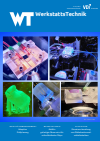wt Werkstattstechnik online , Seite 557 - 562
Zusammenfassung
In der Online-Zeitschrift für Forschung und Entwicklung in der Produktion – wt Werkstattstechnik online – werden die aktuellsten Forschungsergebnisse aus Wissenschaft, Technischer Hochschule und Industrie veröffentlicht - praxisbezogen und zukunftsorientiert. Die wt Werkstattstechnik online erscheint inklusive neun produktionsspezifischen Ausgaben pro Jahr unter der Internetadresse www.werkstattstechnik.de. Die in der wt Werkstattstechnik veröffentlichten Fachaufsätze sind wissenschaftlich-methodisch aufbereitet und grundsätzlich Erstveröffentlichungen. Viele Fachaufsätze sind peer-reviewed: von Experten auf diesem Gebiet – anonym sowie unabhängig von den Autoren – wissenschaftlich begutachtet und freigegeben. Die wt Werkstattstechnik online ist Organ der VDI-Gesellschaft Produktion und Logistik (GPL) sowie der wissenschaftlichen Gesellschaft für Produktionstechnik (WGP).
- Kapitel Ausklappen | EinklappenSeiten
- 469–549 Titelthema Aufsatz 469–549
- 550–556 Titelthema BMBF 550–556
- 557–562 Titelthema Fraunhofer 557–562
Zusammenfassung
Mikrofluidische MEMS-Chips führen, analysieren und verarbeiten Fluide und Gemische. Silizium als Chipsubstrat ermöglicht feinste Kanäle mit sub-mikrometergenauen Strukturen. Anwendungsübergreifend ist die Zufuhr von Proben in diese Kanäle herausfordernd. Oberflächenspannungsphänomene, kleinste Luftblasen und Partikelagglomerationen bilden unüberwindbare Hürden. Anhand eines neuentwickelten Dispensierchips wird ein flexibler Lösungsweg für die Probenbereitstellung und -zufuhr aufgezeigt.
Abstract
Microfluidic MEMS-chips analyze, channel and process fluids and slurries. Monocrystalline silicon as the chip material enables ultra-fine channels with sub-micron structures. Across diverse applications, feeding samples into these chips is challenging. Surface tension phenomena, minute air bubbles and particle agglomerates often pose insurmountable hurdles to the flow. On hand of a recently developed dispensing chip, a flexible solution for sample preparation and feed-in is demonstrated.
- [1] Canon celebrates 30th anniversary of launch of first Bubble Jet inkjet printer | Canon Global. Internet: https://global.canon/en/news/2015/aug26e2.html. Zugriff am 08.08.2023
- [2] MEMS contributes to the inkjet printing industry (r)evolution. Internet: https://www.electronicspecifier.com/news/analysis/mems-contributes-to-the-inkjet-printing-industry-r-evolution. Zugriff am 08.08.2023
- [3] Sharma, S.; Buchholz, K.; Luber, S. M. et al.: Silicon-on-Insulator Microfluidic Device With Monolithic Sensor Integration for<tex>$murm TAS$</tex>Applications. Journal of Microelectromechanical Systems 15 (2006) 2, S. 308–313
- [4] Monserrat Lopez, D.; Rottmann, P.; Puebla-Hellmann, G. et al.: Direct electrification of silicon microfluidics for electric field applications. Microsystems & Nanoengineering 9 1, pp. 1–13
- [5] Mohammadi, M.; Sharp, K. V.: The Role of Contact Line (Pinning) Forces on Bubble Blockage in Microchannels. Journal of Fluids Engineering 137 (2015) 3, pp. 312081–312087
- [6] Valot, L.; Martinez, J.; Mehdi, A. et al.: Chemical insights into bioinks for 3D printing. Chemical Society reviews 48 (2019) 15, pp. 4049–4086
- [7] O‘Connell, C. D.; Onofrillo, C.; Duchi, S. et al.: Evaluation of sterilisation methods for bio-ink components: gelatin, gelatin methacryloyl, hyaluronic acid and hyaluronic acid methacryloyl. Biofabrication 11 (2019) 3, p. 35003
- [8] Chahal, D.; Ahmadi, A.; Cheung, K. C.: Improving piezoelectric cell printing accuracy and reliability through neutral buoyancy of suspensions. Biotechnology and bioengineering 109 (2012) 11, pp. 2932–2940
- [9] Dubbin, K.; Tabet, A.; Heilshorn, S. C.: Quantitative criteria to benchmark new and existing bio-inks for cell compatibility. Biofabrication 9 (2017) 4, p. 44102
- [10] Liu, H.; Li, M.; Wang, Y. et al.: Improving Single-Cell Encapsulation Efficiency and Reliability through Neutral Buoyancy of Suspension. Micromachines 11 (2020) 1
- [11] Pereiro, I.; Fomitcheva Khartchenko, A.; Petrini, L. et al.: Nip the bubble in the bud: a guide to avoid gas nucleation in microfluidics. Lab on a chip 19 (2019) 14, pp. 2296–2314
- [12] Saporito, A.; Quadri, C.; Kloth, N. et al.: The effect of rate of injection on injection pressure profiles measured using in-line and needle-tip sensors: an in-vitro study. Anaesthesia 74 (2019) 1, pp. 64–68
- [13] Donderwinkel, I.; van Hest, J. C. M.; Cameron, N. R.: Bio-inks for 3D bioprinting: recent advances and future prospects. Polymer Chemistry 8 (2017) 31, S. 4451–4471
- [14] Miller, K. M.; Anderson, J. M.: Human monocyte/macrophage activation and interleukin 1 generation by biomedical polymers. Journal of biomedical materials research 22 (1988) 8, pp. 713–731
- [15] Man, P. F.; Mastrangelo, C. H.; Burns, M. A. et al.: Microfabricated capillarity-driven stop valve and sample injector. IEEE Eleventh Annual International Workshop on Micro Electro Mechanical Systems An Investigation of Micro Structures, Sensors, Actuators, Machines and Systems, Heidelberg, Germany, 1998, pp. 45–50
- [16] Devices, M.; LLC: CloneSelect Single-Cell Printer Series | Molecular Devices
- [17] Moon, S.; Kim, Y.-G.; Dong, L. et al.: Drop-on-demand single cell isolation and total RNA analysis. PloS one 6 (2011) 3, e17455
- [18] Kim, Y. K.; Park, J. an; Yoon, W. H. et al.: Drop-on-demand inkjet-based cell printing with 30-μm nozzle diameter for cell-level accuracy. Biomicrofluidics 10 (2016) 6, p. 64110
- [19] Xu, C.; Zhang, M.; Huang, Y. et al.: Study of droplet formation process during drop-on-demand inkjetting of living cell-laden bioink. Langmuir 30 (2014) 30, pp. 9130–9138
- [20] Ng, W. L.; Huang, X.; Shkolnikov, V. et al.: Controlling Droplet Impact Velocity and Droplet Volume: Key Factors to Achieving High Cell Viability in Sub-Nanoliter Droplet-based Bioprinting. International journal of bioprinting 8 (2022) 1, p. 424
- [21] Safka, J.; Ackermann, M.; Martis, D.: Chemical Resistance of Materials used in Additive Manufacturing. MM Science Journal 2016 (2016) 06, S. 1573–1578


